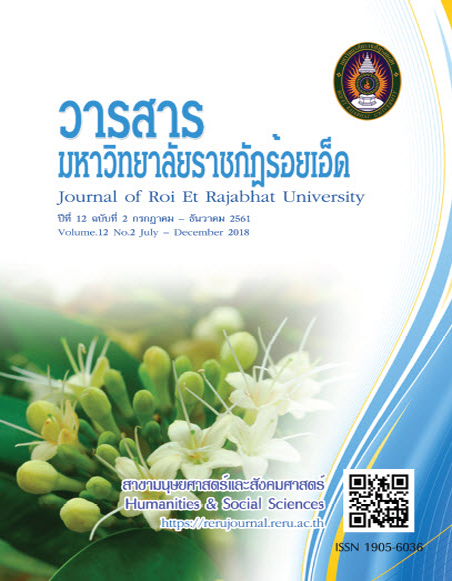CIVIL STATE POLICY FOR LOCAL DEVELOPMENT IN CHUMPHON PROVINCE
Keywords:
Civil State Policy, Development, LocalAbstract
This research aimed to 1) study the level of civil state policy and local development in Chumphon Province, 2) examine the relationship and the influence of the civil state policy on the local development in Chumphon Province, and 3) create a model of civil state policy for the local development in the area of study. The study was mixed in nature-quantitative and qualitative methods. With respect to the quantitative method, the sample of the study comprised 400 people. The study instrument was a set of self- administered questionnaires. In regard to the qualitative method, the small sample group comprised 36 participants. The statistics used for data analysis were frequency, percentage, mean, and standard deviation. The statistics used for hypothesis testing were Pearson’s Product Moment Correlation Coefficient and multiple regression by stepwise and data analysis for qualitative result. The results were as follows. 1) The level of civil state policy and local development in Chumphon Province, as a whole, was rated at a high level. 2) The relationship between the civil state policy and the local development in the area of study, as a whole, was also rated at a high level (.807). The predictor variables could explain factors influencing the local development in the area of study with a statistically calculated percentage of 66.50 ( R2 = .665). The sub-variables in descending order of degree were organizational competency promotion, private and people’s organization promotion and social power, local people encouragement for more development participation, liberty and rights warranty, equilibrium in development participation, and conflict management with peace orientation. 3) According to the civil state policy for the local development in the area of study, Chumphon Province should develop other strategies namely agricultural products and industrial agriculture development, commerce and tourism investment engagement, utility management, and infrastructure reestablishment and preservation. Finally, government’s policies for small and micro community enterprise financial support were crucially needed.
References
นณริฏ พิศลยบุตร. (2559). นโยบายประชารัฐต่างจากประชานิยมอย่างไรและประชาชนจะได้อะไร. สืบค้นเมื่อ 10 มกราคม 2559, จาก https://www.posttoday.com/social/think/409357
ภัณฑิลา น้อยเจริญ. (2557). ปัจจัยที่มีอิทธิพลต่อผลการนานโยบายไปปฏิบัติ ศึกษาความสัมพันธ์ของปัจจัยที่มีอิทธิพล ต่อผลการนานโยบายไปปฏิบัติ และศึกษาข้อเสนอแนะปรับปรุงพัฒนาการนานโยบายกองทุนหมู่บ้านและ ชุมชนเมืองไปปฏิบัติ : กรณีศึกษาผู้กู้เงินกองทุนในจังหวัดหนองคาย. มหาสารคาม: มหาวิทยาลัยราชภัฏ มหาสารคาม.
ยุภาพร ยุภาศ. (2554). ปัจจัยเชิงสาเหตุที่ส่งผลต่อการนำนโยบายเพิ่มพลังอำนาจให้ประชาชนเพื่อแก้ปัญหาความยากจน วิเคราะห์กรณี : การดำเนินงานโครงการพัฒนาศักยภาพของหมู่บ้าน/ชุมชน (SML) ในภาคตะวันออกเฉียงเหนือ. อุบลราชธานี: มหาวิทยาลัยอุบลราชธานี.
วันชัย วัฒนศัพท์. (2559). การจัดการความขัดแย้งด้วยสันติวิธี. กรุงเทพฯ: สถาบันพระปกเกล้า.
ศรีปริญญา ธูปกระจ่าง. (2546). ทัศนคติของประชาชนในกระบวนการชุมชนเพื่อสร้างภูมิคคุ้มกันยาเสพติด. วิทยานิพนธ์ ศิลปศาสตรมหาบัณฑิต. กรุงเทพฯ: สถาบันพัฒนาบริหารศาสตร์.
สรัญญา จุฑานิล. (2556). การบริหารเครือข่ายของสถาบันพัฒนาองค์กรชุมชนสานักงานปฏิบัติการ ภาคตะวันออกเฉียงเหนือ. กรุงเทพฯ: สถาบันบัณฑิตพัฒนบริหารศาสตร์.
สฤณี อาชวานันทกุล. (2559). ประชาชน ประชานิยม และประชารัฐ (จบ). สืบค้นเมื่อ 20 ตุลาคม 2559, จาก https://thaipublica.org/2016/03/populism-pracharat-5
สำนักงานคณะกรรมการพัฒนาการเศรษฐกิจและสังคมแห่งชาติ. (2559). นโยบายประชารัฐ. สืบค้นเมื่อ 20 ตุลาคม 2559, จาก https://ubondopa.com/db/02-02-2016
อิศราภรณ์ ชมชื่น. (2556). ปัจจัยที่มีความสัมพันธ์กับการเสริมสร้างพลังทางสังคม (Social Empowerment) ของประชาชนในเขตกรุงเทพมหานคร. กรุงเทพฯ: สถาบันบัณฑิตพัฒนบริหารศาสตร์.
R.F. Elmore. (1997). Bridging the Gap Between Standard and Achievement. Washington, DC: Albert Shanker Institute.
Taro Yamane. (1973). Statistics : an introductory analysis. New York: Harper and Row.
Downloads
Published
How to Cite
Issue
Section
License
บทความที่ได้รับการตีพิมพ์เป็นลิขสิทธิ์ของวารสารมหาวิทยาลัยราชภัฎร้อยเอ็ด
ข้อความที่ปรากฏในบทความแต่ละเรื่องในวารสารวิชาการเล่มนี้เป็นความคิดเห็นส่วนตัวของผู้เขียนแต่ละท่านไม่เกี่ยวข้องกับมหาวิทยาลัยราชภัฎร้อยเอ็ด และคณาจารย์ท่านอื่นๆในมหาวิทยาลัยฯ แต่อย่างใด ความรับผิดชอบองค์ประกอบทั้งหมดของบทความแต่ละเรื่องเป็นของผู้เขียนแต่ละท่าน หากมีความผิดพลาดใดๆ ผู้เขียนแต่ละท่านจะรับผิดชอบบทความของตนเองแต่ผู้เดียว





